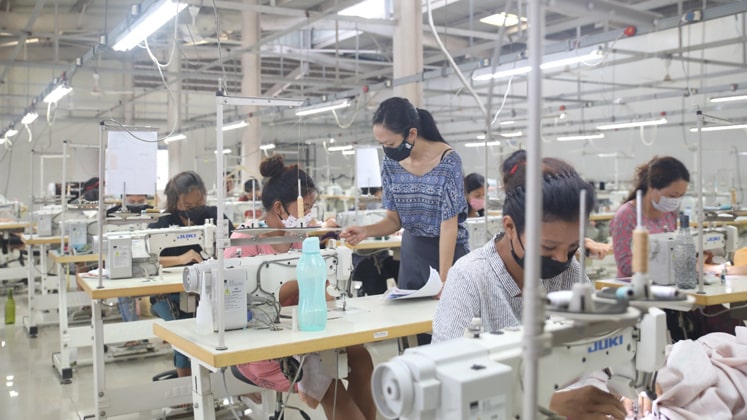North East Region (NER) has been a strong focus for the Government of India aiming to establish industries for around two decades ever since the Ministry of Development of North Eastern Region was formed there. These efforts have seen drastic positivity in the last seven years with a lot of infrastructural and entrepreneurial developments that have seen the light of day. Even in the recent budget, Rs. 1500 crore centrally-funded scheme named ‘Prime Minister’s Development Initiative for North-East’ (PM-DevINE) has been dedicated exclusively for the region over and above all other schemes.
Of all the industries, the one which has been the talking point in NER is textiles and right from North East Investors’ Summit to specific schemes like North East Region Textile Promotion Scheme (NERTPS), significant initiatives have been taken up to promote apparel and textile clusters there. Under these schemes, projects worth around Rs. 1,040 crore covered NER’s handicrafts, handlooms, agro-textiles, geo-textiles and apparel also. So far, the Government has released Rs. 806.73 crore under this out of its share of Rs. 965.01 crore.
Recently, Minister of State for Textiles Darshna Jardosh laid the foundation stone of the apparel and garment unit in Kokrajhar (Assam). She informed in the parliament that the Central Government is providing financial assistance of Rs. 18.18 crore for each apparel and garment making centre for infrastructure capacity building under NERTPS. Under this initiative to promote apparel manufacturing, each North East state has been allotted 3 units with 100 machines each. These 24 centres, across all 8 states, are operational with 100 per cent Government funding and the facilities are made available to entrepreneurs having a background in textiles/fashion for starting their units in ‘Plug & Play’ mode. However, all that glitters is not gold! In discussion with various stakeholders involved in North-East apparel industry, Apparel Resources (AR) found that the outcome of these centres is just decent against the investment and thrust of the Government.
Apparel manufacturing in NER still operating at a laggard pace!
Almost 2400 sewing machines in 24 units of 8 states have been installed in NER in recent years. All three units of Meghalaya and one unit each in Arunachal Pradesh and Guwahati are not operational from almost the last one year. Not only that, from Day-1, all these units have been utilising a maximum 30 per cent of their existing capacities as they never have enough orders! The situation got worse as pandemic hit the businesses.
“I never saw the units running at even 50 per cent capacity as they were not having orders,” said a technical expert (who has spent five years in NER in sewing machine servicing) to AR on the request of anonymity.
Read More:
This observation is also backed by The School of Livelihood & Rural Development (SLRD) which managed to run three units of Meghalaya for 15 months but was forced to close them finally. Abhijit Sharma, Mission Director, SLRD said that his organisation didn’t get the full support of the Government which was a major reason to close the operation. “Skilling was one of the most important aspects to develop industry in Meghalaya but we didn’t get component fixed for skill development despite our best efforts. At the same time, we didn’t get support like washing infrastructure, the peripheral wall of the units which were under Government support. We also invested around overall Rs. 40 lakh of our own but were forced to wind up finally,” claimed Abhijit.
In case of Sikkim also, only Rs. 8.76 crore has been issued so far, while the cost of infrastructure and machineries assigned and handed over to National Building Construction Corporation (NBCC) directly by the Ministry of Textiles is Rs. 14. 26 crore! At the same time, Rs. 3.92 crore was proposed for Capacity Building assigned to the Project Implementing Agency (DHH).
Reasons behind less development of apparel manufacturing…
Other major reasons behind early closures of these centres include lack of availability of quality raw material locally (as the NER produces mainly silk and handloom fabric only), and lack of aggressive marketing approach.Companies like Paradigm Enterprises and Mega Matrix, Noida; Fabric Plus, Guwahati are involved in the apparel making centres of Assam, however, as we learned, these centres are just surviving.
Commenting on this issue, Prayaag Barooah, Chief Marketing Officer, Fabric Plus, Guwahati– that works for Emporio Armani, Aditya Birla Group and Fab India, said, “Apart from silk, there is no quality raw material available in this region and we are dependent on Kolkata for the same which is almost 1,000 km away from Guwahati. Secondly, there is no proper and continued hand-holding by the State Government. There is no policy support from the State Government for the garment industry. We have to bear high cost compared to other established hubs as they have the advantage of producing in bulk.” It is observed that fabrics in few of the units in NER are being imported from China and Myanmar.
When the comments from Fabric Plus,which is mainly a spinning unit having expertise in handloom-based products and is also the biggest unit of the world for Ahimsa Silk, are this negative, one can imagine how other players are surviving in NER!
In terms of skilled labour, despite training efforts being made in North East, the initiatives have not given impressive and desired results on ground level. The region also lacks good and experienced trainers who have the expertise of training and technical knowledge as well. The current situation prevails even after the establishment of NIFT, Shillong that has been existent since 2008. When approached by Apparel Resources, NIFT Director refrained from commenting on the issue!

Ranjit Dutta, Ex-Minister for Handloom & Textiles, Assam and a senior politician also didn’t share what NER achieved when it comes to the growth of the garment industry. Vineet Lall, Director, Paradigm Enterprises and Mega Matrix was vocal in sharing where things are going wrong as he mentioned that finding good trainers is really a big challenge in North East. “We have sent an expert from NCR there who is further training the trainers there,” claimed Vineet. So far, MegaMatrix has trained almost 4,000 workers and many of them are working in respected companies like Gurgaon-based Pearl Global.
Thrust of the Government has primarily been on developing local entrepreneurs…
The thrust of the NER Government as well as Centre Government is to promote local entrepreneurs, and not to attract investors from others hubs. And majority of the local entrepreneurs are lacking in their approach to go aggressive and make garment manufacturing available and successful business.
Endorsing the same, Hokishe K Assumi, Director (Industries & Commerce), Nagaland commented, “Yes, our priority is to promote local entrepreneurs and we have not invited investors from Mainland India. Local entrepreneurs are just lacking in marketing in other states as the population of Nagaland is just 3 million,” accepting the fact that one out of three units in Nagaland is doing reasonably good, while remaining two are performing below par!
Similar situation prevails in Mizoram also where two units are operational by local entrepreneurs, while one is being treated as a training centre only. This is one of the reasons why not even a decent-sized organised factory is there in NER by any well-known group or export house in any of these eight states. “States like Gujarat or Jharkhand have a strong focus on the garment manufacturing industry, so why anybody from India will come here to North East to start their units,” shared Prayaag.
This lack of thrust of the local governments in NER on garment making is hurting the already existed factories there and, opining on the same, Angel Hazarika, Founder, DC Apparels, Guwahati – that mainly caters to local institutional clients – said that a proper action plan from the state governments can boost garment making in a decent way irrespective of the distance of North East from major established hubs.
“Overall population of entire North East is less than 5 crore and there is no heavy demand of westernwear here. Only youth prefer such garments, so micro and unorganised factories are producing sportswear, westernwear for local youth and local clubs,” commented Angel.
There are few other units working in various areas of NER like Mongken Apparel Unit in Nagaland…Mongken is a brand initiated by the Department of Underdeveloped Areas (DUDA) and is a hand holding initiative to create economic opportunities for local designers, skilled artisans and craftsmen from Nagaland, with special focus on the underdeveloped regions of the state. But again, the unit is entirely dedicated to promote local clothing products only.
Recently during the visit of this centre, Rajeev Chandrasekhar, Minister of State for Skill Development and Entrepreneurship also said that such centre needs more support as well as they have to work patiently under the joint collaboration of Centre and State Government to see growth.

“…Mindset needs to change! Still there is not much awareness about NER and people from other regions don’t really have a good impression about NER,” stated Amenba Yaden, who used to be Parliamentary Secretary for Industries and Commerce, Nagaland and is now an MLA, Tuli (Mokokchung).
Is this just Government’s failure or industry’s stakeholders in NER are responsible too?
Currently, there are 73 ITIs in NER with seating capacity of 17,000. The State Governments in NER and Central Government are undoubtedly putting joint efforts to train the trainers at these facilities, and this is in contrary to what training companies in NER claim! MSDE has also set up two National Skill Training Institutes (NSTI) in the region – one each in Tripura and Meghalaya. Apart from this, the Government has also released Rs. 60 lakh towards upgrading of training equipment particularly in Manipur. Now that when the industry claims the Government initiatives are a failure, who should be held responsible if budget for centres has been released, institutes have been established, focus on training has already been there and regular review meetings are being conducted?
People opt for training in NER and aspire for jobs in other states!
A lot of people of NER are working as migratory workers in other garment hubs of India. But an ecosystem, which can attract this skilled and experienced workforce back to the North East, is missing, forcing these workers to work in other states. They have more opportunities and better earnings in other states.








